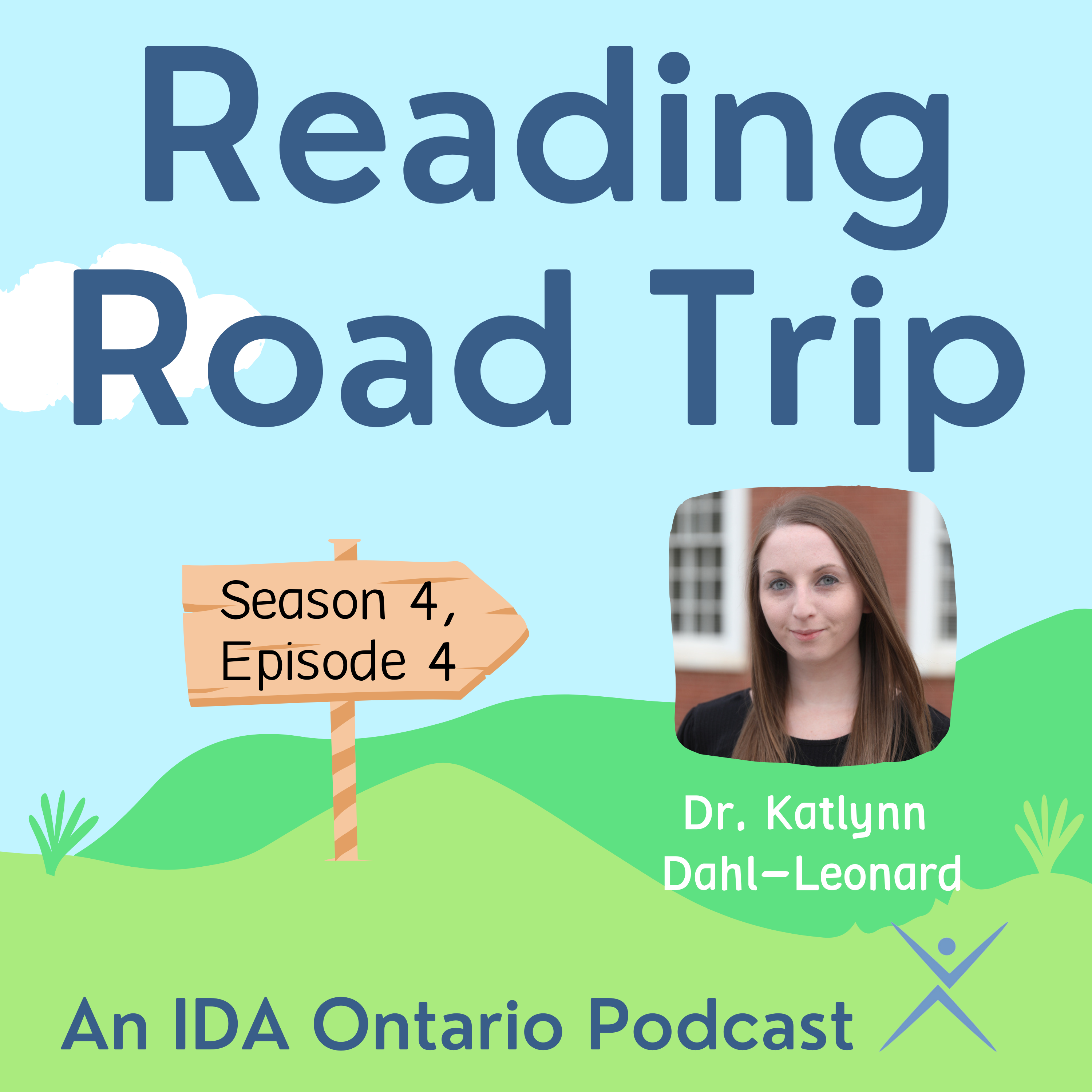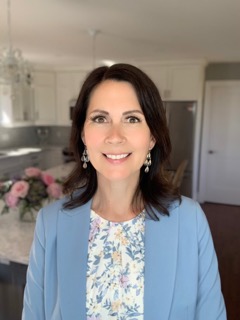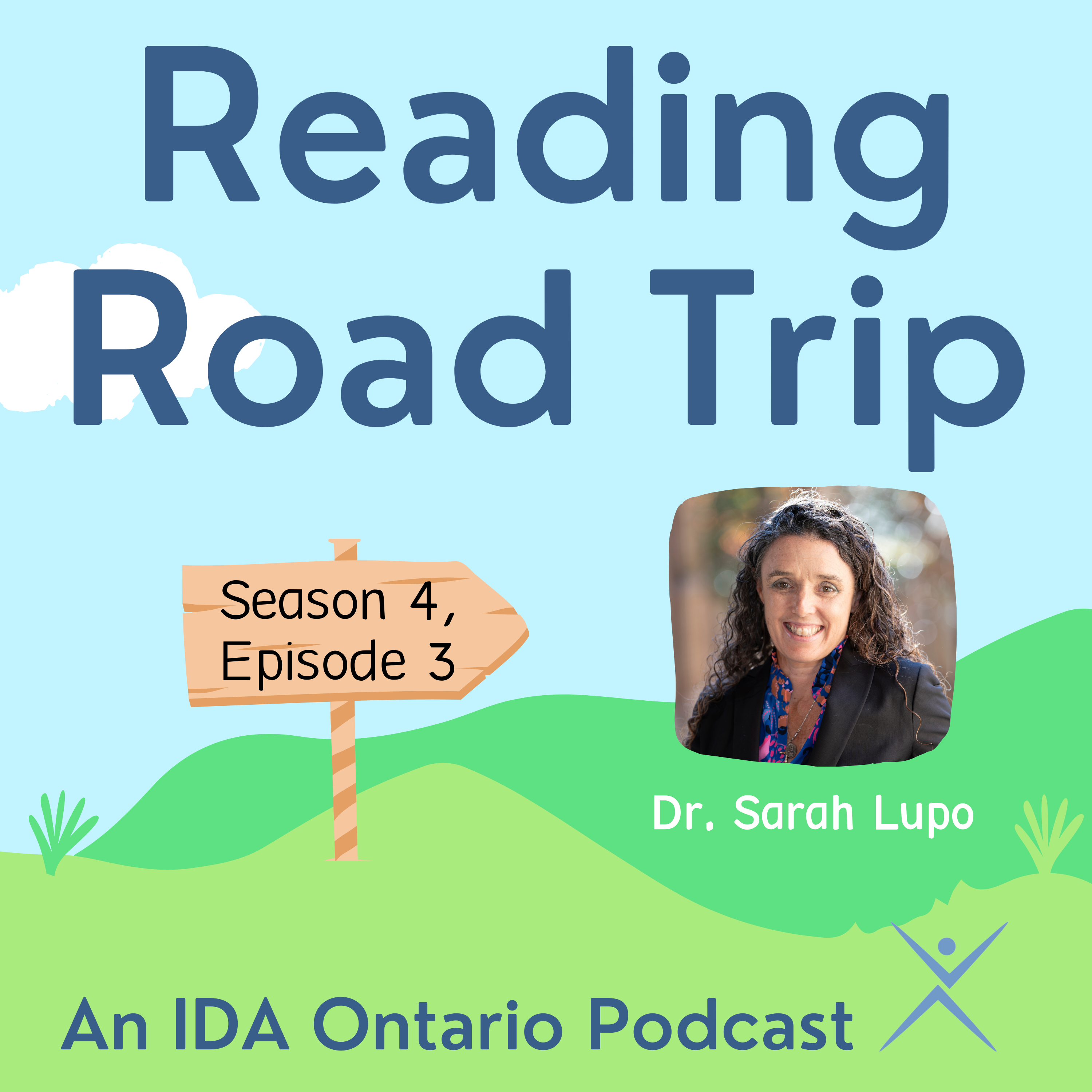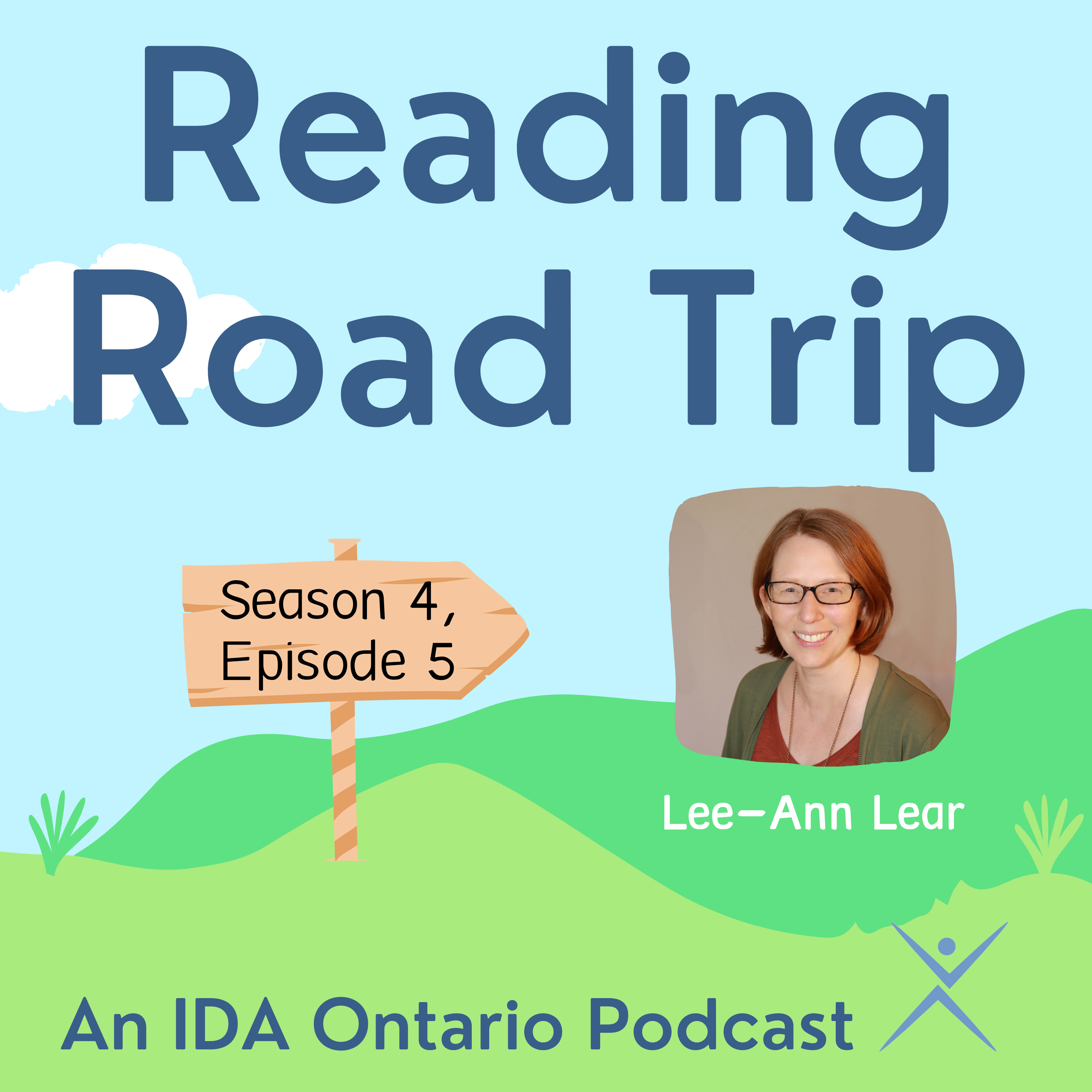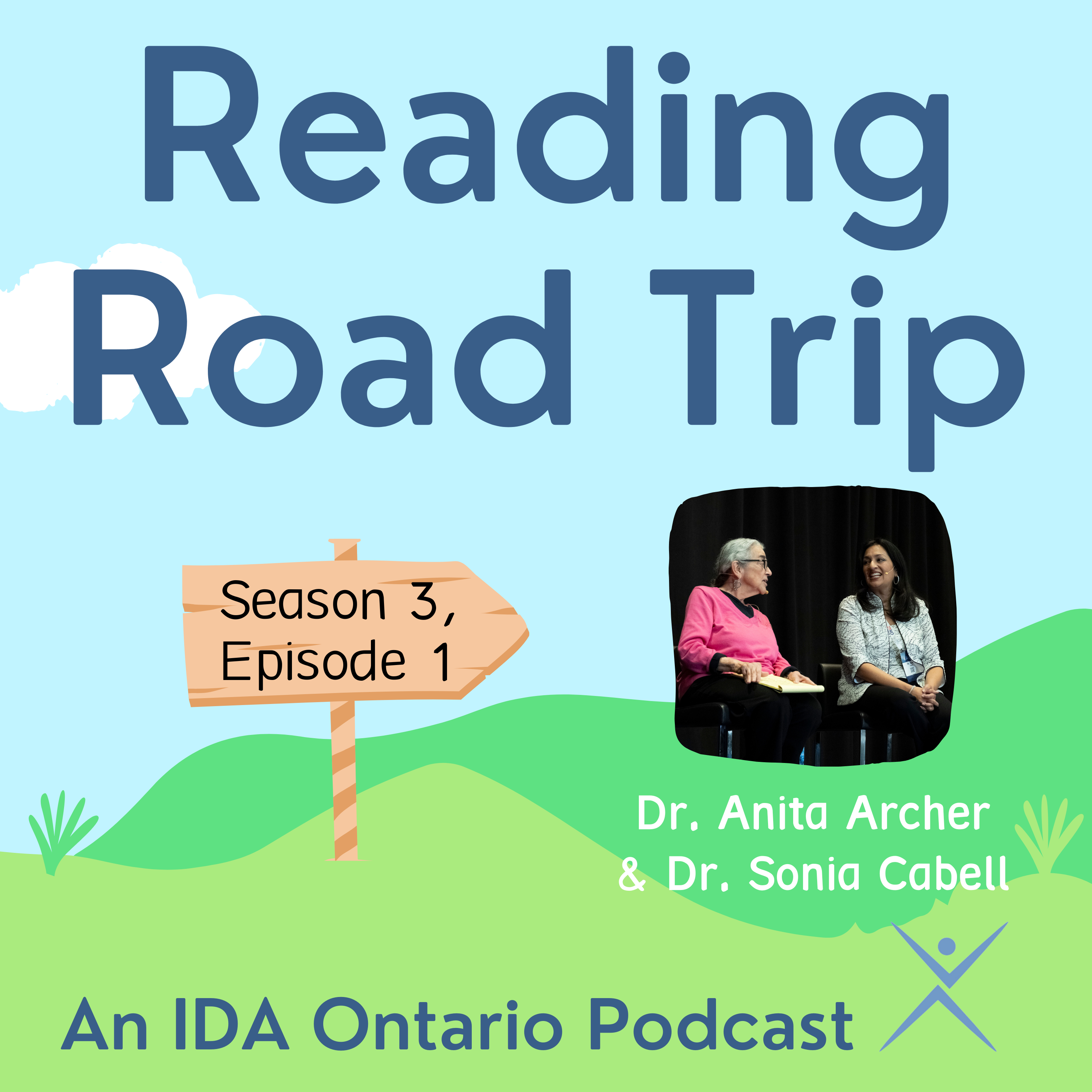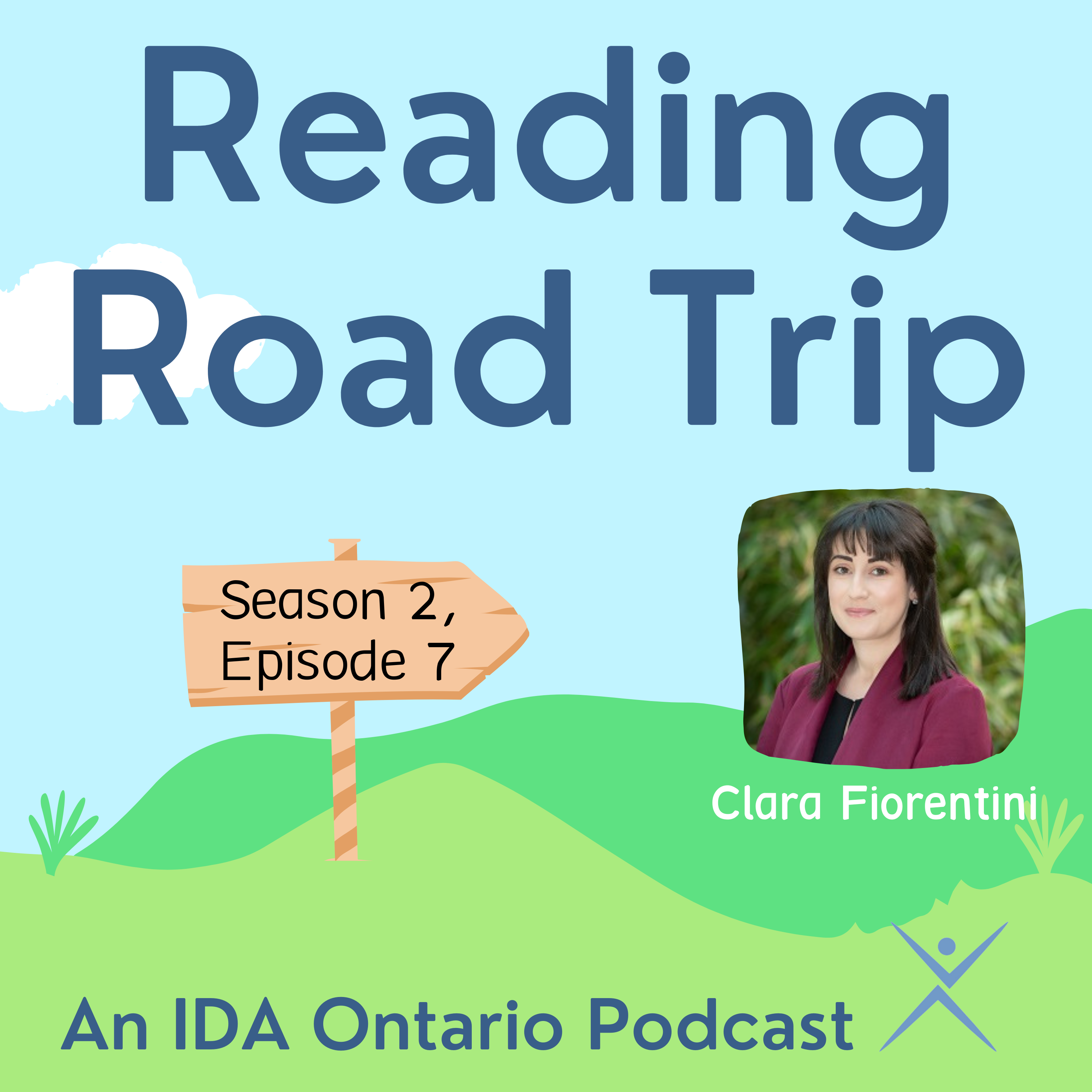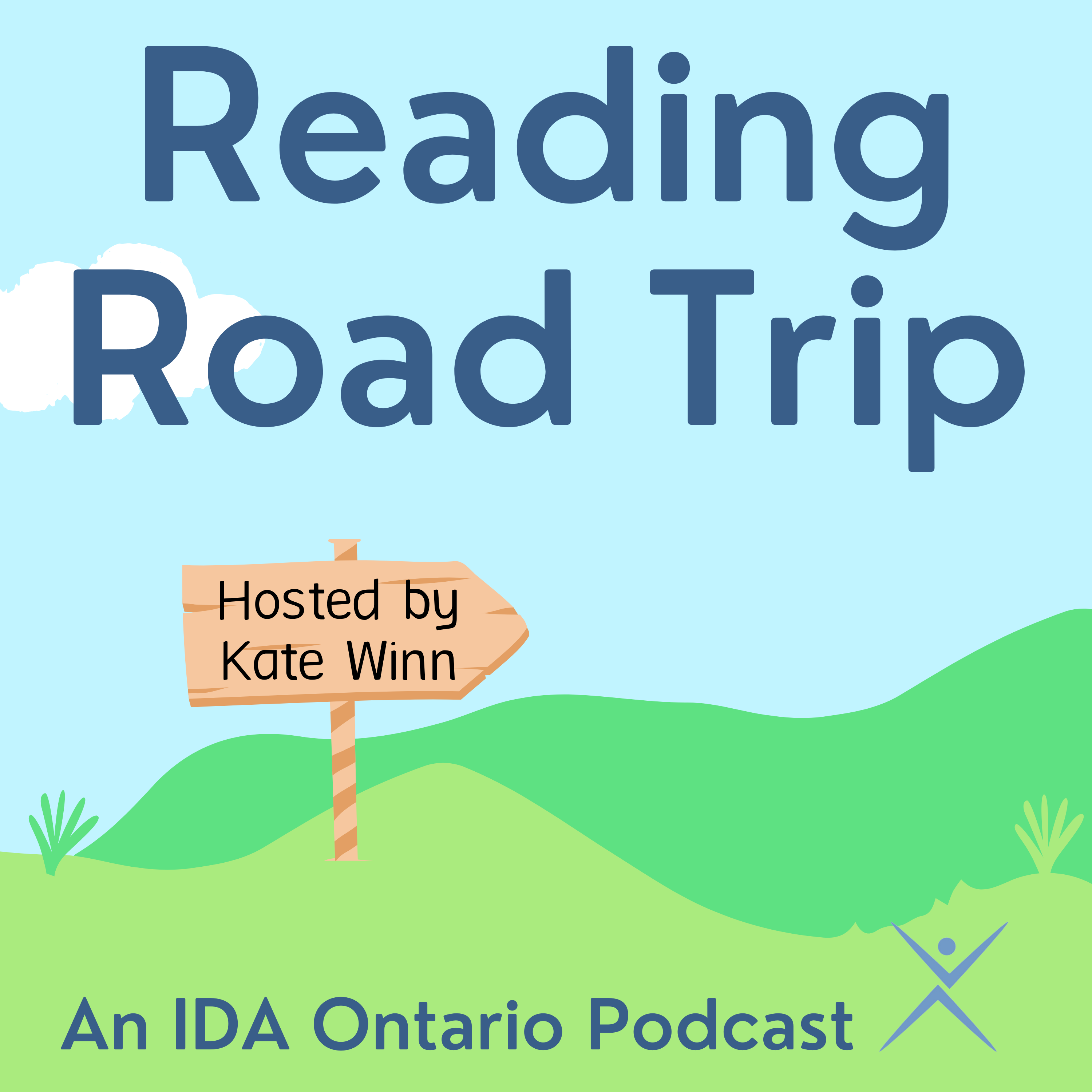[00:00:05] Kate Winn: Hello to all you travellers on the road to evidence-based literacy instruction. I'm Kate Winn, classroom teacher and host of IDA Ontario's podcast Reading Road Trip. Welcome to our fourth episode of Season 4.
Before we get started, we would like to acknowledge that we are recording this podcast from the traditional land of the Mississauga Anishinaabe. We are grateful to live here and thank the generations of First Nations people for their care for and teachings about the Earth. We also recognize the contributions of Métis, Inuit and other Indigenous peoples in shaping our community and country.
Along with this acknowledgement and in the spirit of truth and reconciliation, we'd like to amplify the work of Indigenous artists and today we are sharing the picture book If You Were Here by Kathy Stinson, illustrated by Maya McKibbin.
For kids ages 3 to 7, this lyrical picture book explores the complex emotions around missing a loved one with stunning illustrations by Ojibwe artist Maya McKibbin.
I wish I could show you this great big meadow like a sea of lacy clouds.
In this beautiful ode to nature and mindfulness, a child sets out to explore the environment around their home using all their senses.
Yet someone important is missing. Someone the child wishes could be there on this journey.
Expressive text by Kathy Stinson leaves room for readers' own interpretations about who the child in the story might be missing, while Indigenous illustrator Maya McKibbin's gorgeous images capture the lush beauty of the natural world and the tenderness of a child's emotions. The perfect book for helping a child navigate loss or missing someone that can't be there with them.
Add this title to your home or classroom library today. And now on with the show.
[00:01:56] Kate Winn: I'm so excited to introduce my guest here this week on Reading Road Trip, Dr. Katlynn Dahl-Leonard. She is an assistant professor of literacy education at the University of Houston. Her research primarily focuses on effective literacy instruction, especially for elementary students with or at risk for literacy learning difficulties.
She is particularly interested in supporting teachers' understanding and implementation of evidence-based literacy practices. Welcome to the show.
[00:02:25] Dr. Katlynn Dahl-Leonard: Thank you. Thanks for having me.
[00:02:27] Kate Winn: So my co-producer Una Malcolm and I have been wanting to do an episode on implementation science and we were just waiting for the right guest. And when we read a study that you did, Exploring the Feasibility of Implementing the SPELL Links to Reading and Writing Intervention, we thought, you know what, let's get her on the show to talk a little bit about implement science. So the first thing I want to ask you is what is implementation science?
[00:02:54] Dr. Katlynn Dahl-Leonard: Yeah, yeah, that's a really great question.
But it's also a really big question. And so when I was thinking about this, I was worried I wasn't going to capture like all the pieces of it. So I actually gave it a Google search, which I know is a bit silly, but I wanted to see kind of what all, you know, with AI and everything nowadays, like what all was kind of incorporated into implementation science.
And I'd actually like to read off what the Google search said and then I'll comment on it.
So Google said implementation science is the study of methods to promote the systematic uptake of research findings and other evidence-based practices into routine practice.
And so it focuses on bridging the gap between research and practice by understanding and addressing barriers or facilitators to the adoption and implementation of effective interventions in real-world settings.
So that's kind of what Google had to say about it. And I actually think it was like pretty accurate.
And like I said, there's also a lot of pieces to it. So I wanted to kind of unpack it a little bit.
One thing that is interesting about implementation science is that it's rooted in the medical field actually, and that's not really uncommon for like the field of education to kind of take things, borrow things, leverage, let's use the word leverage, leverage things from the medical field and kind of adapt them for more educational purposes.
So that's kind of one thing about it. But then really it's about studying how to effectively integrate those evidence-based practices into real-world settings. And really the primary goal I think is to close that research-to-practice gap that I'm sure your audience is very well aware of and hear about all the time. And so whenever we're thinking about this in terms of education and education practices, we're really interested in studying how teachers are understanding and implementing these evidence-based practices in their classrooms.
So it's really interested in taking like a closer look at why teachers are either successful or maybe not so successful, maybe have some difficulties with implementing specific practices in their, you know, real-world context.
And then another key part of implementation science is that it really tries to use all this information to develop strategies to address those implementation issues.
And so, and really again, the goal is that like we want teachers to be more effective in implementing these practices. And it's important because if they're using evidence-based practices, the idea is that they'll have improved student outcomes.
So I know I read off a Google definition, but I also kind of want to give, now that I've said all that kind of my own take on it too.
So whenever I think of defining implementation science in relation to literacy instruction, I think it involves studying teachers use of evidence-based literacy practices and then using that information to better support their implementation of those practices and improve student outcomes.
[00:05:55] Kate Winn: So why would you say implementation science is important for teachers? I mean, we have a lot of teachers who listen to this show. They're listening right now. Why do they care about this piece of it?
[00:06:05] Dr. Katlynn Dahl-Leonard: All right, that's another great question.
And I think because you know, again, going back to that research to practice gap, so we know we have all this research, we know kind of what works and we want to really ensure that teachers are using these practices that we know that work and in their classrooms, but we also want to support them in doing so. And I think that's kind of where this implementation science piece comes in. Because we don't want to just hand teachers a curriculum or a program, whatever it is, and say now do it right. That's not implementation science. Implementation science is really kind of figuring out what is working and what's not working, but also why. So that why piece are important.
So trying to work with teachers to understand the why a little bit better so that we can better support them in their classrooms. Kind of what I'm getting at is that we think it's important to develop these or cultivate these collaborative partnerships with teachers. As a researcher, working with other researchers, I can't do this alone. It's really important that we collaborate with teachers so that the research informs practice and so that practice informs research so they're kind of mutually beneficial is idea behind those partnerships. And then again, kind of really hammering home like why it's important to teachers is because we all want to see student improvement. We want to see student outcomes that are being impacted by the interventions they're using. And so we really want to ensure that they're using the right tools, the right way, you know, using those evidence-based practices to ensure that student outcomes are improving.
[00:07:39] Kate Winn: And why do you think there is still such a gap between what we know from research and, and classroom practice? I mean, I know I'll still hear people say something like, oh, is this a new thing? Like, well, you know, the National Reading Panel came out in 2000, but like this is some newfangled study that came out last week that all of a sudden we're all jumping to get on board with. Why do you think there's still such a gap?
[00:08:01] Dr. Katlynn Dahl-Leonard: Yeah, yeah. So you know, kind of to your point about the Reading Panel, we have decades of literacy research even before that, right. Because the Reading Panel in part gathered a bunch of already existing studies and combed through those and gave us some information about those.
So we really have like decades of research about, you know, what works in terms of literacy instruction, improving literacy outcomes. But for a really long time, and I will say this is my understanding of the situation for a really long time, researchers weren't really communicating with practitioners, with teachers, with other educational stakeholders, whether that's, you know, district leaders, school level leaders, those sorts of things. There was kind of this lack of communication about what research was telling us about effective literacy instruction. So there's just this gap between the research findings and what was actually going on in classrooms. I do think though that in recent years the field has made some strides towards kind of addressing the issue. And so I always think about there's a paper by Dr. Emily Solari and her team and it is focused on translational science and that is kind of this idea about translating research findings into authentic classroom settings. And that paper actually kind of lays out some guidance. I think they call it a roadmap about how as a field, as researchers, some steps we can take throughout the research process to more effectively communicate with educational stakeholders and have them involved in the research practice partnerships that I was talking about earlier.
So there is that kind of going on right now. We are as a field trying to make, kind of trying to close the gap. And then I think another thing that's kind of helped us head that direction, too has been state-level legislation. So there has been a large increase in the number of laws and different types of legislation things going around at the state level about evidence-based literacy practices in schools. And they do vary quite a bit from state to state.
But you know, kind of some general things that are going on are related to preservice teacher preparation and inservice teacher professional development as well as kind of assessment. So like screening assessments trying to identify students who are at risk for literacy difficulties and related to instructional practices. And this is where we kind of start getting into those list of approved curricula and you know, having schools or districts that are asked to choose from a pre-approved list and kind of using what's considered evidence-based curricula in their classrooms. So those things are happening. And then one other thing I wanted to mention with this question was that even whenever teachers are using these like state-approved evidence-based literacy curriculums that might like look different in different teachers' classrooms. So even though we think this is kind of like an important thing that's happening in terms of trying to close that research-to-practice gap. It will look different for different teachers in different contexts, which is why it's important to kind of, you know, going back to that implementation science piece to be looking at kind of what factors influence the feasibility of using these programs in their classrooms. Yeah, I think that's about for that.
[00:11:19] Kate Winn: No, that's great.
[00:11:20] Kate Winn: And something that I'm finding as a teacher, too, is I think more connection between researchers as people and teachers as people. It's not just a case of, you know, researchers writing papers that other researchers read because the teachers like, I mean, I'm totally a nerd, and so I'll read some papers. Some it'll just be the abstract and the discussion if I think it's relevant.
And that's just me. But a lot of people are never going to touch those. But even things like this year, I'm going to the SSSR conference. It's being held in Calgary in July. There's a practitioner day this year, so researchers will be speaking directly to practitioners. And even things like, you know, I see researchers who are active in some of the key Facebook groups who are chiming in where those frontline people are to weigh in on things. Or even like yourself being on this show here today, just being able to bring that research piece directly to teachers, which I think is great.
[00:12:11] Dr. Katlynn Dahl-Leonard: Yeah, I definitely think there's been a big push in our field in the last decade or so to really try to make those connections between researchers and practitioners. And I also think a lot of teachers are becoming researchers too. They've, you know, almost kind of made this shift from being classroom teachers to oh, I actually want to do research. And my main focus will be communicating these findings to teachers. I recently graduated from the University of Virginia and I think half my cohort was teachers that kind of were in this similar position where they're like, well, I want to work with teachers. I want to make sure that they understand what the research is saying and you know, know where to find evidence-based practices and what that even means and all these things. So I definitely think there's been a big push that direction in our field.
[00:12:56] Kate Winn: That's great. When it comes to implementation science, there's some terminology that I just want to work out a little bit for our listeners. So one piece of vocabulary is determinants. So when we're talking about implementation science, what do we mean by determinants?
[00:13:12] Dr. Katlynn Dahl-Leonard: Yeah, so broadly, determinants are the factors that influence the feasibility of implementing certain practices. So kind of typically in this, you know, context, we're talking about those evidence-based literacy practices in authentic classroom settings. So kind of what factors influence those?
And determinants can be factors that hinder implementation, which we usually call barriers or determinants can be factors that support implementation. And we typically call those facilitators.
So barriers is kind of, sorry, determinants is kind of an umbrella term for both barriers and facilitators.
And then I can kind of dive in a little bit more to kind of where this language, this terminology comes from too. So basically in implementation science there's a commonly used framework which is called the Consolidated Framework for Implementation Research. And I think the short acronym is pronounced CFIR, so I'm going to use CFIR and I apologize if that's not the right term. But that framework really identifies different levels of determinants that we kind of think about whenever we're in those authentic school settings. And those include the intervention level, the teacher level and the school level.
And I'll explain each one a little bit. The intervention level determinants are kind of what they sound like. It's about the intervention itself.
So that's kind of, you know, how the design of the intervention is, how complex it is, even things like cost of the intervention, whether it could be adapted. So things like that really just related to the intervention. And then the next one is teacher-level determinants. And again it's like it sounds, it's related to the teacher characteristics.
So it might be things like their personal fulfillment with implementing the intervention or it could have, it can include things like their capability is the term that's used in this framework. But really that means things like their knowledge and skills, their self-efficacy to implement the intervention. It's also things like motivation and commitment. So anything kind of that has to do with like the teacher's role in implementing the intervention. And then the next level is the school level.
And so these ones are things that are about the general characteristics of the school. So might be like how communication occurs within the school or just kind of the school's culture. And it can also include things that are specific to implementing the intervention within that school.
So those might be things like priority, like how much of a priority is it to implement this intervention? What are the incentives that are around for implementing the intervention, Resources are available and also kind of access to the intervention and you know, all the information they need to be able to implement it. So those are kind of the three levels and those are the things we primarily focused on in the study that we're going to talk about today. And then I have one more thing to add about the determinant piece. I want to kind of emphasize, like, why it's important to look at these factors. And it really obviously goes back to that, you know, implementation science. But really looking at these factors in particular context helps us be able to develop strategies that address context-specific determinants. So again, going back to that idea of that, you know, an intervention, we don't want to just hand it to teachers, since they do it right. We want to know what we need to tweak, what we need to make better for the particular context that they're using that intervention in. So it's kind of what determinants are.
[00:16:37] Kate Winn: Yeah. And we'll be digging into some specific examples. It'll all become clearer for people as they continue to listen when we talk about your specific study. Because we can get into some nitty gritty about, like, the barriers that might hinder the implementation and the facilitators that would support the implementation and that sort of thing, what you found, before we get into all those details, could you just kind of give everybody a description of this study, kind of what this was all about?
[00:17:02] Dr. Katlynn Dahl-Leonard: Yeah.
So the study was actually part of my dissertation work, I think I already mentioned, I very recently graduated from the University of Virginia.
And so while I was a doctoral student, I led a feasibility study of a literacy intervention. And that intervention is called SPELL-Links to Reading and Writing. And I'll just refer you to SPELL-Links moving forward because it's kind of a long title to say each time.
But SPELL-Links is an explicit, systematic word study intervention, and it uses what's called a speech-to-print approach to instruction.
So it's a little bit different than a lot of traditional intervention programs that use a print-to-speech approach.
And we're not here to talk about all that today, but I did want to kind of note that it is maybe a little bit different than some traditional interventions.
And SPELL-Links does have previous research, not from my study, but there's previous research showing that it improves word reading and spelling and writing.
So it already kind of has some evidence behind it.
And for the purpose of the study I led, we really wanted to explore a little bit more about how teachers implement it. And so we wanted to look at, we had three kind of goals as we were conducting the study. And the first one was we wanted to explore the extent to which teachers were able to implement the intervention with fidelity. And we also wanted to understand the determinants. So kind of what we've already started to touch on barriers and facilitators to teachers' implementation. And then we were also interested in teachers' perceptions of the intervention. So we wanted just to learn a little bit more about how they felt about whether it was important, whether it was feasible, whether it was effective, those sorts of things. So kind of just gathering again, just information from teachers about what's really going on when they implement this intervention.
So for the study, we partnered with six reading intervention teachers and we provided them with all the materials that they needed and the training that they needed. They implemented SPELL-Links with small groups of students. The goal was for 30 minutes a day, four days a week, and they were working with students who are in grades two and three.
And then for the purposes of the study, we collected data.
So we used four different data sources which included implementation logs. So teachers were kind of tracking how often they taught the program, how much time they spent teaching it, those sorts of things. We also conducted observations where we went and observed them implementing SPELL-Links. And then the teachers participated in individual interviews where we asked them lots of questions about determinants of implementing the intervention. And they also completed a survey that focused more on getting their perceptions of the intervention. And the reason we collected all these data sources is so that we could kind of look at them together and see where things aligned or didn't align and, you know, help us get a better picture of what was going on more holistically. And so that's kind of the set up for our study.
[00:20:01] Kate Winn: Great. And I like how you pointed out that there's, you know, other research about the effectiveness of SPELL-Links as an intervention. That's not what this part was about. So this wasn't about student achievement and tracking, all of that kind of stuff. It was about the teacher implementation piece, which I think makes this so interesting. I know your study focused on fidelity, and I've heard in the science of reading world, some people say, oh, that's the new F word, fidelity.
But there are five dimensions to fidelity that I understand. What are the five dimensions? And then which ones did you focus on for this study?
[00:20:36] Dr. Katlynn Dahl-Leonard: Yes. Yeah, no, it's so funny that you bring that up, but that is very true. Some of my early work focused on fidelity. And right away I was kind of hit with this idea of like, oh, not everyone likes, you know, looking at fidelity and thinks that it’s important. Okay.
So for this study, we did focus on the five dimensions of fidelity that are conceptualized by Dane and Schneider. And the reason I'm saying this is because kind of going back to that idea of fidelity, not necessarily being widely agreed upon. There's different conceptualizations of fidelity, especially across disciplines. But even within the field of education, there's some differences. And folks will use different frameworks when talking about fidelity. So for the purpose of our feasibility study, we focused on Dane and Schneider's five dimensions of fidelity.
And those five dimensions are dosage, adherence, quality, responsiveness, and differentiation. And I can break these down a little bit. The first one, dosage, like it sounds, it's the amount of instruction that students receive.
So if they're supposed to receive an intervention four days a week for 30 minutes, they're getting it four days a week for 30 minutes is, you know, the goal for dosage for adherence. That refers to the extent to which the critical components or the key pieces of the intervention are being implemented as intended. And so this is probably the thing that people most associate with fidelity is adherence. So really, just if they are adhering to what the program tells them to do, they're saying what the program tells them to say, really adhering to, you know, if there's a script, they're reading the script the way it's supposed to be read, that kind of thing. So that's adherence.
And then the third one is quality of instructional delivery. And this one's a little bit more about, like, the qualitative aspects of implementation.
So we can think about things like pacing or whether the implementer is prepared so has all the materials ready, those sorts of things that might not be captured in adherence, but they're still kind of important to how the intervention is being delivered. And then the fourth one is responsiveness. So responsiveness is the extent to which students respond to the intervention. And so that is like you were saying earlier about that, like, evidence-based, the effectiveness of the intervention, which we're not focusing on. So that one is responsiveness, and then the last one is differentiation. So that's about the extent to which the intervention is different from another treatment or another intervention or a comparison condition. We didn't focus on this one because it's typically more about whenever you're conducting, like a randomized controlled trial, you want to know what other students on average get students, control group.
[00:23:31] Dr. Katlynn Dahl-Leonard: Yeah. And then so for our study, just to recap, we focused on the first three. The dosage, adherence, and quality.
[00:23:38] Kate Winn: Okay, great.
Before I ask you the next question, I just wanted to share a story. Just thinking about fidelity. And it's so interesting that this was part of your dissertation work, because last year I actually got to work with a doctoral student and Jenny Passalacqua at Florida State University, and she was doing research on spelling intervention with kindergarten students. And so I got to be the interventionist, which was really cool. But every single session was video recorded. She watched every single one. I had all the paperwork because it was all about, like, series of prompts and things like that. I won't give away too much of her, too much of what she was studying, but and, you know, like, and then she would score and I would score, and we'd be comparing things like just hat piece of just sort of making sure that the fidelity piece was absolutely there for that. And I mean, obviously, we can't videotape every teacher's lesson every day and have somebody watch it to ensure, you know, anything. But just the experience I had doing that, I think was good for me to sort of see how this works in that kind of research world.
Okay, so you've laid out your study, talked about what you were looking at. So what were your findings then? What did you find?
[00:24:47] Dr. Katlynn Dahl-Leonard: Yeah, kind of going back to be a three broad research questions that we were interested in. So I'll kind of talk a little bit about each one of those.
And the first one was about the fidelity of implementation. As a reminder, we use the implementation logs and those video observations to really look at fidelity a lot like what you're talking about where we're doing recording, we're checking logs to make sure teachers are at least trying to implement the intervention most days, that kind of thing. And then we use that data to look at dosage, adherence, and quality. And on average, the teachers in our study were able to implement the SPELL-Links intervention with high adherence to the activity steps. And they delivered it with high quality, but they did not implement it with the intended dosage of 30 minutes a day, four days a week, for kind of the duration of the study. So even though, so basically that kind of says, like, when they did implement it, they did it well. Right. They did it kind of with fidelity, but they just weren't really implementing it as frequently as they were supposed to. So that's interesting in itself, I think.
And then our next research question was about those determinants. So both barriers and facilitators to implementation and those, we really used that interview data to kind of explore that piece of it.
And through those interviews, we identified four barriers which I’m going to list them out. But I know sometimes it's a little rambly so, the first one was insufficient intervention training.
The second was basically the intervention content structure was too complex.
And then the third is that there was a lack of compatibility with the existing practices at their school or in their classrooms. And then the fourth was lack of alignment with goals for student performance. And this was either goals set by the teachers, by the schools, by the district, or by the state even. Right. So we often think about those like state-level assessments. And these were second and third graders. So we are kind of at that in those grades, preparing them for those state assessments. So there was some, basically mismatch between what the program was doing and what the goals were for those students.
And I will say the first two that I mentioned were those intervention-level barriers. So about the intervention itself, which really just led to that intervention being too difficult for teachers to implement. And then the last two are more about school-level barriers. And with those two, I think it's important for us to think about that school-level barriers aren't really within the teacher's control. Those are almost outside of their scope and really fall typically with within the responsibilities of the school administration, administrators, school leaders, those sorts of upper-level personnel. And so I always kind of like to, you know, make that caveat because it's not that we're, you know, trying to blame the teachers for, you know, whatever it is that's not working. And we just, we do know that there's a lot of. And that's kind of the interesting part of looking at these different levels too is that we know there's a lot of different things at play here. And these are just kind of what we identified as the barriers. And then we did identify two facilitators. And the first one was teacher capability. So we actually measured, I didn't talk about this, but we measured their knowledge and their self-efficacy through surveys at the beginning of the year and also through the interviews and, you know, observations. We were able to kind of talk with them and look at some of these things. And really teachers having high levels of knowledge and self-efficacy were facilitators of implementation.
And then the second facilitator was peer support from other teachers at their school. So for that one we had, I can't remember three or four or five different schools. I can't remember exactly how many schools it was, but one of our schools had a group of two or three teachers in it and they would kind of work together. Right. So they, during their lunch breaks or you know, planning times, they would kind of talk about, hey, here's where I'm at, here's what's going on. Did this part make sense to you or do you already have this material prepped? Those sorts of things. And that really facilitated them being able to implement the intervention more effectively.
So those were kind of the determinants that we identified. And then our last research question was about teachers’ perceptions of the intervention, and we focused on the importance, the feasibility and the effectiveness. So it's kind of three pieces there. And really from that we looked at the survey results and they very much aligned with what we gathered from the interviews and from the observations. I don't think we had any, like, big surprises. I think the main thing that became abundantly clear in the interviews was that teachers were not satisfied with the intervention training or with the content and structure of the intervention itself. So I feel like they just had some issues with the intervention. And it wasn't necessarily anything at the teacher or school level that they really, like, pointed out. They really were focused on that intervention piece. But yeah, I think on average it kind of came out that they were pretty neutral about the intervention. But I think again, putting all these pieces, all these data sources together, I think that's what stood out to me about it.
[00:30:06] Kate Winn: Well, I like how you mentioned there's only so much that we classroom teachers can do at, you know, at the teacher level.
So I'm curious to know, what do you think the results of your study mean for, you know, school administrators, for system leaders? What do you want them to know? I mean, based on the things with this one specific study, of course, but based on different barriers that you found or different facilitators that you found, what do you think those people need to know moving forward in terms of bringing the science of reading into their classrooms or districts?
[00:30:39] Dr. Katlynn Dahl-Leonard: Yeah. And kind of as you started to hint at, like, this was a small sample of teachers, it was just about one intervention. So, you know, we're kind of limited in what we can say about recommendations and things like that. But I will say, based on our findings, there's a few things, and I will say our findings in combination with other research that's out there, there's a few things that I feel like we can kind of ask, you know, school leaders to consider when they are, you know, working on this kind of thing. And so the first one is about whenever they are adopting a new literacy intervention.
And this kind of goes back to, like, with all that new legislation that's going through and you know, having to find new interventions, maybe even some schools, one thing to think about is that making sure that they're selecting an intervention that's compatible with the existing practices at their school and that have sufficient alignment with school level, district level, state level goals for students.
This is one that's probably like easier said than done, but really just thinking kind of big picture, right? So not just selecting a program from a list because the state has decided it's evidence-based, but really thinking through like what that intervention looks like and how it matches on to what's happening at your school, like what goals you have for your students and those sorts of things. So kind of thinking a little bit big picture whenever you're selecting an intervention.
And then another one to think about is creating environments where teachers can collaborate with one another. So where there's a group of teachers that are using the same program with the same, you know, maybe kind of group of kids, whether it's reading intervention teachers or if it's a kindergarten classroom. Right. Making sure that there's teachers that have time to talk and discuss and, and think about the intervention together and maybe provide support to one another as they implement the intervention.
And then kind of a last one is that school leaders might want to also be thinking about how to provide more opportunities for teachers to gain knowledge and skills that are going to help them implement these interventions.
And whether that is a one-time training or ongoing support like instructional coaching, just thinking through how they can better support their teachers. Again, we never want to just hand teachers a curriculum and say, hey, use this. Bye. Right. We want to make sure they're supported in doing it. So just kind of figuring out what that looks like in their specific context and then yeah, I think those are my main things I can say based on our findings.
[00:33:12] Kate Winn: Okay, is there anything I haven't asked you about anything else where you're just thinking, oh, I should mention that for Reading Road Trip listeners.
[00:33:22] Dr. Katlynn Dahl-Leonard: I think kind of going back to some of the earlier questions about implementation science and why teachers should care, basically, I think one thing to just kind of note is that we are on the same team. Like we have the same goal. We want to improve literacy outcomes for students.
And so I think it's just so important that researchers and practitioners are working together to make sure that these students have kind of the most effective literacy instruction possible.
So just we're a team and we want to work with you and we hope you want to work with us.
[00:33:54] Kate Winn: Well, that's wonderful. And by bringing your message here to us today, you're helping to directly reach educators which is so great. Dr. Katlynn Dahl-Leonard, thank you so much for being a guest here this week on Reading Road Trip. This has been fascinating.
[00:34:08] Dr. Katlynn Dahl-Leonard: Thank you so much. Bye.
[00:34:14] Kate Winn: Show notes for this episode with all the links and information you need can be
[email protected] and you have been listening to Season 4 Episode 4 with Dr. Katlynn Dahl-Leonard.
Now it's time for that typical end-of-the-podcast call to action. If you enjoyed this episode of Reading Road Trip, we'd love it if you could rate and or review it in your podcast app as this is extremely helpful for a podcast, and of course, we welcome any social media love you. Feel inspired to spread as well. Feel free to tag IDA Ontario and me. My handle is thismomloves on Twitter and Facebook, Katethismom loves on Instagram and Kate Winn on Blue Sky. Make sure you're following the Reading Road Trip podcast so you don't miss a single episode in this jam-packed season. New shows will be released on Monday mornings all summer long.
We couldn't bring Reading Road Trip to you without behind the scenes support from Brittany Haynes and Melinda Jones at IDA Ontario.
I'm Kate Winn and along with my co-producer Dr. Una Malcolm, we hope this episode of Reading Road Trip has made your path to evidence-based literacy instruction just a little bit clearer and a lot more fun.
